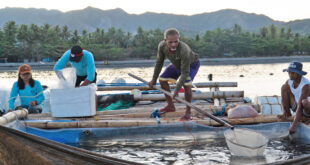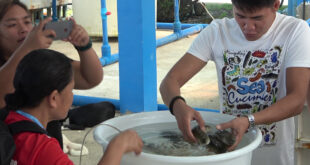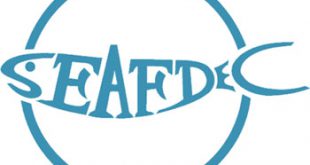 Although the technology applies to all the three species of mud crab (Scylla serrata, S. tranquebarica, and S. olivacea) available in the Philippines, S. serrata or the giant/king crab has been the focus of culture in the hatchery/nursery and grow-out pond due to its economic viability.
Although the technology applies to all the three species of mud crab (Scylla serrata, S. tranquebarica, and S. olivacea) available in the Philippines, S. serrata or the giant/king crab has been the focus of culture in the hatchery/nursery and grow-out pond due to its economic viability.
Procedure:
- Obtain healthy adult crabs 500-700 g for S. serrata and 320-500 g for S. tranquebarica and S. olivacea with orange ovaries (‘aligi’) and complete legs as source of broodstock from ponds or traders.
- Put crabs in an empty basin and pour seawater over them slowly. Transfer crabs to basin containing 150 ppm formalin for 30 minutes to disinfect. Transfer crabs in tanks provided with sand substrate.
- Feed crabs with mussel, fish and/or marine worms at 10-15% of crab biomass daily. Change the water 3-4 times a week. Sampling for berried females (females with spawned eggs attached to the flap. Crabs spawn within 2-4 weeks depending on the stage of ovarian maturity when obtained.
- Retrieve berried crabs and disinfect in formalin. Stock each crab in a 500-liter tank with aerated seawater. Feed crabs but discontinue feeding when eggs become brown.
- Siphon out detached eggs and excess food before water change. Change about 80% of the total water volume in the tank daily. Retain 20% of water in the tank to prevent egg desiccation.
- Check for hatching and remove the crabs after all the eggs are shed. Turn off aeration in the hatching tank. Allow dead zoeae, unhatched eggs, feces and other wastes to settle. Siphon them out.
- Cover the tank and siphon zoeae that concentrate in the lighted area with 2-cm diameter hose. Transfer in a bucket with aerated seawater. Estimate the total number of zoeae.
- Stock about 80 zoeae/li in tanks. Feed with rotifers at 10-15 ind/ml until zoea 4 or 5 and newly hatched Artemia at 0.5- 1 ind/ml from late zoea 3 to early megalopa. Feed later stage of megalopa with larger Artemia and/or minced fish or mussel meat.
- Change 30-50% of the water volume every 5 days until harvest. Harvest crab instar (crablets) and stock in net cages.
 SEAFDEC/AQD Southeast Asian Fisheries Development Center | Aquaculture Department
SEAFDEC/AQD Southeast Asian Fisheries Development Center | Aquaculture Department


